GEMOC's international links
BACKGROUND
GEMOC’s international links provide leverage of intellectual and financial resources on a global scale, and an international network for postgraduate experience. International activity includes funded projects and substantial collaborative programs with exchange visiting programs in France, Norway, Germany, United Kingdom, New Zealand, Canada, USA, Taiwan, Italy, Spain, South Africa, South America, China, Brazil, Japan, Thailand and Russia.
FUNDED COLLABORATIVE PROJECTS COMMENCED OR ONGOING IN 2010 INCLUDE:
- An MOU was signed with the China Academy of Science, (Beijing) involving the Institutes of Geochemistry and Geophysics. This will allow for exchange of personnel, co-tutelle PhD projects, and joint access to the complementary analytical equipment at each institution. In the first exchange, Dr Chuanzhou Liu arrived at GEMOC for a 6-month stay aimed at transfer of GEMOC's technology for in situ analysis of Os isotopes.
- Trace elements and fluids in diamonds and relevance to mantle fluids and processes with Professor Oded Navon (Hebrew University, Israel), Professor Thomas Stachel (Edmonton, Canada) and Dr Jeff Harris (University of Glasgow, UK). Funded by an ARC Discovery Project, including the PhD project of Ms Ekaterina Rubanova. Dr Zdislav Spetsius (Mirny, Siberia) visited GEMOC for analytical work connected with the project.
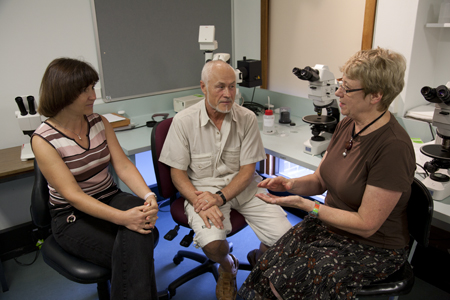
Dr Zdislav Spetsius (Mirny, Siberia) visited GEMOC for analytical work connected with the diamond project; here in a discussion with Elena Belousova and Sue O'Reilly.
- Shear-induced metal segregation in ordinary chondrites, a collaborative project with Professor N. Petford 2007-2009 (Bournemouth University, UK).
- The first million years of our solar system – stellar nucleosynthetic inputs, solid formation and planet building with Professor Joel Baker (Victoria University, New Zealand).
- Core formation and degassing of the Earth, a collaborative project with Dr S. Nielsen, Professor A. Halliday (University of Oxford) and Dr M. Rehkamper (Imperial College, London).
- Partitioning of chalcophile elements between metal, sulfide and silicate, a collaborative project with Dr D. Frost and Professor D. Rubie (Bayreuth University, Germany).
- Detailed 2-D and 3-D structure of the Kaapvaal Craton in several time slices, using mantle-derived xenocrysts, a collaborative project with De Beers.
- Global Lithosphere Architecture Mapping, involving analysis of crustal evolution, the composition of the lithospheric mantle and the interpretation of seismic tomography, a collaborative project with BHP Billiton and Professor Steve Grand (University of Texas at Austin)
- Dr Kelsie Dadd was one of a team of 50 international scientists who participated in a nine-week Integrated Ocean Drilling Program (IODP) expedition in the Bering Sea in 2009. Kelsie sampled ice-rafted debris and ash layers in the recovered sediment cores. Ash shards are currently being separated from the sediment for analysis. The sampled ice-rafted debris consisted of 148 pebble-sized clasts. The physical properties (including rounding and sphericity) of over 100 clasts were analysed. Low roundness at some sites indicates the presence of glaciers or perennial sea ice in those locations, while most of the other pebbles are likely to have originated from fluvial environments and beaches with low wave action due to the presence of seasonal sea ice.
- Collaboration continued with Professor Massimo Coltorti and Dr Costanza Bonadiman from the University of Ferrara on the geochemistry of amphiboles, mantle metasomatism, and the age and origin of the lithospheric mantle beneath the Cape Verde Islands and Antarctica.

Bill Griffin and Professor Sun-Lin Chung in a lively and liquified discussion of a TerraneChron® study to unravel the timing and tectonic history of regions in Tibet.
- A TerraneChron® study to unravel the timing and tectonic history of regions in Tibet continued as a collaborative program with the National University of Taiwan (led by Professor Sun-Lin Chung), and has expanded to include collaboration with Nanjing University and the Tibet Institute, Beijing.
- The nature of the lithosphere in Mongolia, and lithosphere extension in the Taiwan region, with Dr Kuo-Lung Wang (Institute of Earth Sciences, Academia Sinica, Taiwan). The institute sponsored a workshop on "Frontiers in Geochemical Research" in conjunction with the 2010 Western Pacific AGU meeting in Taipei, in which Bill Griffin, Sue O'Reilly, Norman Pearson and Mei-Fei Chu from GEMOC participated.
- Collaboration with colleagues at the University of Jean Monnet, St Etienne, including Professor Jean-Yves Cottin, Dr Bertrand Moine and Dr Marie-Christine Gerbe (with reciprocal funding from both sides) expanded. A formal agreement between the two universities includes PhD exchange, academic exchange and research collaboration relevant to the nature of the lithosphere in the Kerguelen Archipelago, Crozet Islands and the Hoggar region of Algeria. In addition, studies on magma mixing in granites continued under a co-tutelle agreement (Anne Fonfrege).
Norman Person with collaborators from the University of Montpellier, France, Dr Olivier Alard and Professor J.-L. Bodinier while on field work on the famous Lherz massif in the Pyrenees.
- Collaboration with colleagues at the University of Montpellier continued with the
co-tutelle PhD project of Yoann Gréau (submitted late 2010) and projects on the mantle budget of platinum group elements, microstructures of meteorites and mantle rocks, and ophiolites. A new collaboration commenced funded by the DIISR Grant "Probing the composition of the early Solar System and planetary evolution processes". Exchange visits of Dr Olivier Alard and two postgraduate students from Montpellier (Jennifer Chaufard and Valerie Migeon) to GEMOC and Dr Norman Pearson to Montpellier, advanced the research on this project. - Igneous rocks, mineral deposits, lithosphere structure and tectonic setting: southeastern China and eastern Australia. This collaboration with Nanjing University has expanded from an AusAID grant under the ACILP scheme with Professor Xisheng Xu (Nanjing University). Co-tutelle PhD student Yao Yu arrived at GEMOC from Nanjing, to carry out further FTIR studies of water in mantle-derived xenoliths.
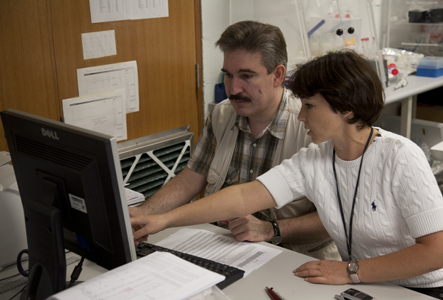
Kreshimir Malitch and Elena Belousova disecting the history of NiS deposits related to the Siberian Traps. - Several collaborative projects continued with Dr Kreshimir N. Malitch (Department of Geochemistry, All-Russia Geological Research Institute (VSEGEI), St Petersburg) including: (1) the nature and origin of zircons from the intra-continental paleorift-related ultramafic-mafic intrusions of the Noril'sk area (northern Siberia, Russia). The latter include world-class PGE (platinum-group element)-Cu-Ni sulfide deposits related to Noril'sk-1, Talnakh and Kharaelakh ultramafic-mafic intrusions, subeconomic PGE-Cu-Ni deposits related to Chernogorsk, Zub-Marksheider and Vologochan intrusions, the prospective Mikchanga intrusion and non-economic Nizhny Talnakh, Zelyonaya Griva and Kruglogorsk intrusions; (2) analysis of Os-(Ir-Ru) alloy grains in two world-class Au-PGE placer deposits associated with the Guli clinopyroxenite-dunite massif (northern Siberia, Russia) and the Evander Goldfield within the Witwatersrand Basin (South Africa). The main aim of this study is to place further constraints on osmium-isotope signatures of the mantle sources for Os-rich alloy grains at Guli and Evander, which (along with Witwatersrand grains) represent the oldest terrestrial platinum-group minerals known so far.

Jerry Friedman, Nick Fisher, Elena Belousova and Bill Griffin examining Elena's Zircon database to test new statistical approaches for recognising structure and population.
- Professor Jerry Friedman (Stanford University) and his Australian colleague Dr Nick Fisher visited GEMOC for a week to renew a collaboration with Bill Griffin and Elena Belousova on the development of new statistical approaches for recognising structure and populations in GEMOC's large geochemical databases. In this case the week was spent testing some new ideas, using Elena's zircon database (see GEMOC Publications 93, 139, 209, 265, 269, 299).
- Collaboration with Professor Yuri Kostitsyn from the Vernadsky Institute of Geochemistry and Analytical Chemistry (GEOKHI), Russian Academy of Science includes studies on continental crust formation in the modern subduction zone: Kamchatka Peninsula. Professor Kostitsyn is also involved in the GEMOC project testing models for continental crustal growth using the TerraneChron® database.
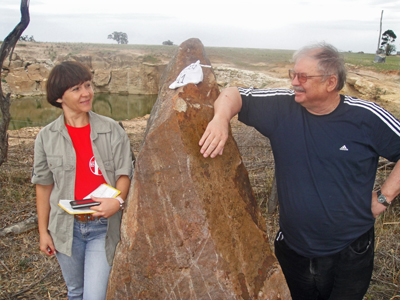
Elena Belousova and Alexander Kremenetsky in the field in South Australia. - A collaborative project with Alexander Kremenetsky, Director of the Institute of Mineralogy, Geochemistry and Crystal Chemistry of Rare Elements (IMGRE), Moscow, Russia, utilised our TerraneChron® approach to look at giant provinces of heavy-mineral placer deposits in Australia and Russia.
- Studies with Professor Jianping Zheng (China University of Geosciences, Wuhan) on the evolution of the lithosphere beneath several parts of China, crustal evolution in the North China Block, the Yangtze Block and southeastern China, and the UHP metamorphism of Dabie-Sulu peridotites. A co-tutelle Phd student from Wuhan will arrive in 2011 to work on one of these projects.
- Studies on Cathaysia's place in Rodinia, crustal evolution of southeast China, and crustal evolution of the Yangtze Block with Professor Jinhai Yu and Ms Lijuan Wang (collaborative project with Nanjing University and cotutelle program; Lijuan submitted her PhD thesis in late 2010).
- Studies continued with Dr Rendeng Shi (Institute of Tibet Plateau Research, China Academy of Sciences, Beijing) on the age and origin of platinum group alloy phases in podiform chromitites in ophiolites from Tibet.
- TerraneChron® analysis of Proterozoic terrains in Africa, North America and Europe, with several mineral-exploration companies.
- On-going collaboration with BHP Billiton (Dr Kathy Ehrig) and University of Tasmania (Prof Vadim Kamenetsky) looking for the evidence of younger magmatic events (e.g. Grenville-age event) in the magmatic evolution of the Gawler Craton, with a particular focus in the region around the giant Olympic Dam deposit.
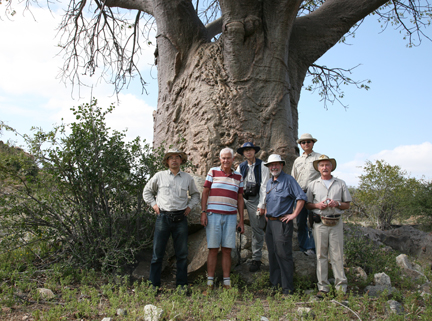
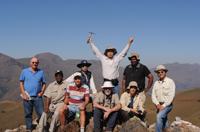
- GEMOC established relationships with the newly established International Precambrian Research Centre of China (IPRCC), with Bill Griffin joining the Board. He also participated in an international field trip to the oldest rocks in southern Africa (the Barberton Greenstone Belt and surrounding areas of Swaziland, and the Limpopo Belt), led by Prof Alfred Kroener, and taught part of a Geochronology Workshop in Beijing, sponsored by the IPRCC.
- Formal visits to Chinese institutions strengthened or initiated collaborative research projects and agreements: Nanjing University; China Academy of Sciences, Geophysical and Geochemical Institutes; China University of Geosciences (Beijing, Wuhan).
- A new collaborative research project was initiated with the Royal Holloway University of London, to look at the crustal evolution and geodynamic history of Southeast Asia. The preliminary results and new constraints on basement ages, granitic magmatism, and sediment provenance in the Malay Peninsula were presented at the European Geosciences Union General Assembly 2010, Vienna, Austria, 2–7 May, 2010 and accepted for publication in Gondwana Research. Another milestone was the submission of Inga Sevastjanova's PhD thesis; other students will begin in 2011.
- A new collaborative research project was started with Dr Sevetlana Bogdanova (Department of Earth and Ecosystems, Lund University, Sweden) looking at the Volgo-Uralia crustal segment, which is the least-known part of the East European Craton. Its crystalline crust is hidden beneath a thick Neoproterozoic to Phanerozoic cover but disclosed by thousands of drillings. In conjunction with the recent reflection seismic profile, this collaboration provided the first isotopic study of the Bakaly granitoid block in eastern Volgo-Uralia, which represents a subsurface sect
 ion of the layered upper-middle crust. The outcomes of this project were presented at the 5th International Archaean Symposium (Perth) in September, 2010 and published in American Journal of Science (December, 2010).
ion of the layered upper-middle crust. The outcomes of this project were presented at the 5th International Archaean Symposium (Perth) in September, 2010 and published in American Journal of Science (December, 2010). - A field trip to the Balkan ophiolites of Serbia (Bill Griffin and Sue O'Reilly) has started a collaboration with Dr Nada Vaskovic, of Belgrade University, on the geochronology of these and related rocks
Bill Griffin and participants in an international field trip to the Barberton Greenstone Belt, sponsored by the IPRCC.
Sue O'Reilly has started a collaboration with Dr Nada Vaskovic of Belgrade University, on the geochronology of Balkan granites - here with one of their samples.
Refer to the Research Program and Postgraduate sections of this Report for details of other projects.

 GEMOC ARC National Key Centre
GEMOC ARC National Key Centre